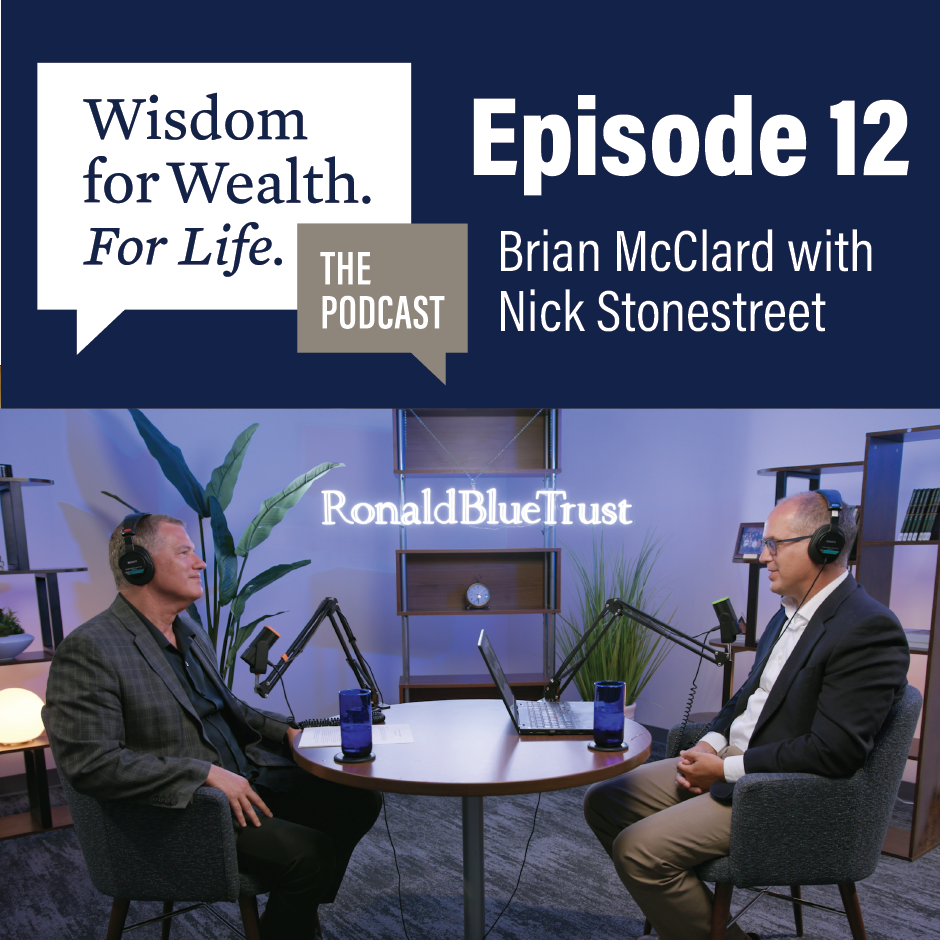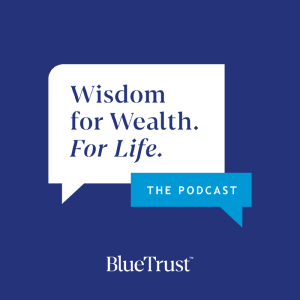“Wisdom for Wealth. For Life.” Episode 12: Inflation, Recession, U.S. Dollar, and the Markets … where are we headed next?
Our CEO and chief investment officer, Nick Stonestreet, recently sat down with our head of investments, Brian McClard, to share some of their insights about current economic issues, what may lie ahead, and how a financial plan is the best means of weathering unpredictable economic conditions. You can view their full discussion in the most recent episode of our “Wisdom for Wealth. For life.” podcast.
Episode 12: Inflation, Recession, U.S. Dollar, and the Markets
The following are some key takeaways and highlights of the discussion.
Inflation Takes Center Stage
Rising prices for everything from groceries to gas to housing have caused considerable concern among the American public and around the globe. In June 2022, the Consumer Price Index had risen 9.1% over the previous 12 months, the largest 12-month increase since November 1981. If the prices themselves haven’t been troubling enough, shipping delays and the sight of empty shelves have signaled an increased scarcity of goods.
What is driving these high prices and difficulty getting products to market? In 2020, with the onset of COVID-19, the U.S. economy partially shut down. At the same time, massive amounts of monetary and fiscal stimulus were poured into the economy. The combination of these two events hampered supply while boosting aggregate demand, creating a recipe for dramatic supply chain imbalances and the price inflation we’re now experiencing. Two years later, those effects are now diminishing as the fiscal stimulus recedes, the Federal Reserve (Fed) begins tightening monetary policy, our economy opens up and transitions back from predominantly goods-based to more of a service-based economy. Frustrating this transition have been the Russia-Ukraine conflict and COVID-related lockdowns in China, that have contributed to high inflation via the disruption to supply chains.
In order to ensure that inflation doesn’t become entrenched, the Fed has expressed its commitment to bringing consumer price pressures down and has aggressively begun raising interest rates this year. We believe that bond yields are telling us that inflation is expected to come down materially—to the 2.5% range over the next few years—and that the Fed will tip the economy into a recession to help make that happen.
That would take care of inflation for now. More immediately however, is the question of a Fed-induced recession. Consequently, the market’s focus is shifting from inflation to concerns over economic growth and a possible recession.
Talks of a Recession
We are hearing the word “recession” get thrown around a lot in the news, and while there is a technical definition of recession that may be met, accurately identifying a recession is more complicated than that. Even though we are likely about to have two consecutive quarters of negative GDP growth, it is not a forgone conclusion that we are currently in a recession. There is a Business Cycle Dating Committee at the National Bureau of Economic Research (NBER) that will ultimately determine if we have experienced a recession or not, but it likely won’t determine this until months later. This makes the whole recession debate tricky to navigate.
When you look under the hood into the specific components of the economy, the consumer is the biggest driver of economic activity, so it’s important to watch what’s happening to them. Because the Fed has been raising interest rates, interest rate sensitive sectors like housing are starting to slow dramatically. The NAHB/Wells Fargo Housing Market Index (HMI) has experienced a big decline and is back down to mid-2020 levels. Since the housing sector touches so many parts of the economy, it is an early indicator of what will happen to such things as personal income and personal consumption. This softening in housing is a negative signal for future growth.
As we look at personal incomes and expenditures (adjusted for inflation), we observe that they haven’t grown over the last year. So, consumers are starting to retrench. Once consumers dial back their consumption, companies will slow production which dampens earnings. Corporate profits then fall and that’s when employment takes a hit—first through slowing of hiring, but finally through layoffs. While we are currently seeing a slowing in housing and the consumer, corporate earnings and employment are still in solid shape. That’s important because we have never had a recession in the U.S. where corporate profits were strong.
In aggregate, we would characterize the current environment as a slow growth economy that is slowing further which makes it susceptible to shocks and recession. However, we don’t see a reason that a recession has to be deep given high corporate profit margins that can absorb cost pressures, healthy consumer balance sheets, and lack of excess leverage in the private sector of the economy.
The U.S. Dollar
The value of the U.S. dollar has risen materially this year compared with almost every other nation’s currency. The U.S. dollar is the leading global reserve currency, transactions are settled in dollars, debts are denominated in dollars, and commodities like oil are priced in dollars. So, a strengthening dollar generally leads to a decline in corporate earnings and a slowdown in global growth, which only increases the recession risk.
The Financial Markets
It has been an unusual start to the year for stocks and bonds. Both have posted negative returns year-to-date. Most of the drawdown in financial markets can be attributed to the rise in interest rates. What makes this experience so unique is how quickly rates have risen this year combined with how extremely low the starting yields were.
Stocks are not pricing in a recession in our view. The selloff in stocks has been attributed entirely to a contraction in valuations. Earnings have been positive. If corporate earnings remain strong, we could potentially avoid a recession, and stocks may be close to the bottom of their drawdowns. If corporate earnings decline, we are very likely in for a recession and stocks could have further to fall. This is why we’re watching corporate earnings closely.
Stocks always selloff prior to the onset of a recession. So, sidestepping a recession is difficult. On average, recessions begin seven months after stocks have already begun their selloff. Stocks then bottom typically four to five months after a recession begins. The good news is that returns have historically been strong after stocks have bottomed—returning on average 37% over the following year.
The Importance of a Financial Plan
When it comes to investing, our innate human instincts are usually counterproductive. That’s why it’s easy for investors to get disoriented in turbulent markets and make investment decisions that are sub-optimal for their long-term objectives. It is tempting to change investment course during negative market environments. However negative returning markets are part and parcel of the investor experience. Investing doesn’t mean having satisfactory returns every time, rather in time.
Investing is about goal attainment. Therefore, the most powerful way to protect your portfolio is to know your planning goals, anchor your investments to your financial plan, and stick to that plan. That requires thinking through your investment time horizons and the timing of your cash flows. This is important because investment risks are very different for different time horizons and therefore require different types of investment strategies. We help our clients answer all of those questions. And with those answers, we can humbly structure a diversified portfolio that we believe improves the probability of successfully meeting your goals.
If you have additional questions or want to discuss your investment strategy, please reach out to your Blue Trust advisor or contact us at 800.987.2987.

Please note the following financial updates (as of July 29, 2022):
- The Federal Reserve met on July 27 and raised the federal funds rate by .75%, bringing the federal funds rate to a target range of 2.25% to 2.5%.
- The Bureau of Economic Analysis reported on July 28 that Gross Domestic Product (GDP) for the 2nd quarter of 2022 was -0.9% (annualized), subject to further revision. The 1st quarter GDP was reported as -1.6% (annualized).
- As of July 29, 56% of the companies in the S&P 500 have reported actual results for Q2 2022 to date. Of these companies, 73% have reported actual EPS above estimates. Actuals are coming in 3.1% above estimates.
- The blended (combines actual results for companies that have reported and estimated results for companies that have yet to report) earnings growth rate for the second quarter is 6.0%.
In our “Wisdom for Wealth. For Life.” podcast series, we share financial advice and wisdom from our network of wealth advisors and thought leaders in the industry, and from around our community of over 10,000 financially blessed families who apply biblical wisdom to their financial planning and giving.
The podcast is available across most major podcast networks. If you enjoy this episode, please consider writing a review and sharing with friends and family wherever you listen to podcasts:
Thank you and we hope you will enjoy this exclusive content!

